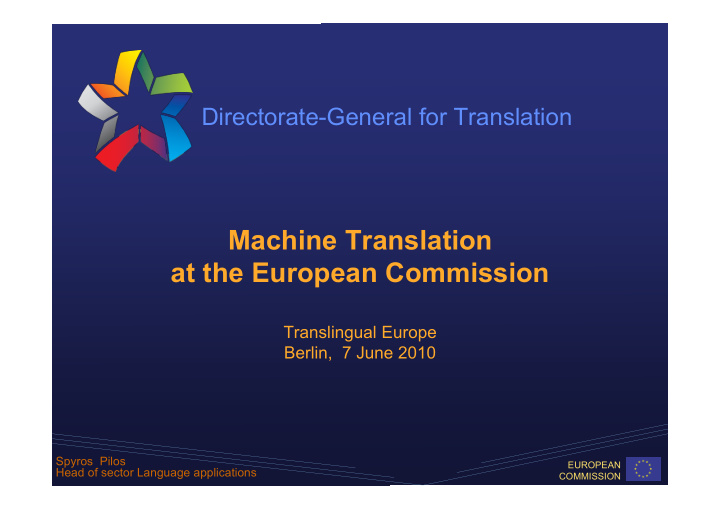



Directorate-General for Translation Machine Translation at the European Commission Translingual Europe Berlin, 7 June 2010 Spyros Pilos EUROPEAN Head of sector Language applications COMMISSION
Machine Translation at the EC Translation@EC MT@EC What next - 2 - Translingual Europe - MT@EC
Translation@EC Directorate-General for Translation (DGT) • Staff: 1750 linguists and 600 support • Production (M pages): 0,9 (1992) 1,2 (2004) 1,8 (2008) • Cost: EC translation: 300 M € all translation and interpretation: 2 € /y per citizen BUT to make europa.eu fully multilingual • translate almost 6,8 million documents • 8,500 translators working full-time for one year - 3 - Translingual Europe - MT@EC
The present: ECMT service • managed by DGT • rule-based machine translation • developed between 1975 and 1998 • 28 language pairs available (ten languages) • since 2006 only maintenance reduced work on dictionary enrichment on a couple of systems • use (M.pages): 1,5 (2006) more than 2,5 (2009) • who uses it and what for − EU institutions and public bodies for gisting − Online services and information systems for raw translation − DGT as a CAT tool - 4 - Translingual Europe - MT@EC
The future: MT@EC service Policy Commission Communication on "Multilingualism” 2008: “ human and automatic translation is an important part of multilingualism policy” Facts ECMT is rule-based and costly to develop Data-driven systems are cheap and quick to develop…. if you have the data Language Technology Watch Market and research observation Tests of commercial and non commercial tools and MT systems - 5 - Translingual Europe - MT@EC
MT@EC Needs – resources - action MT@EC strategy Adopted in June 2009 by DGT Task Force created November 2009 Task Force results April 2010 MT@EC is necessary for the Commission (trust, confidentiality, continuity) Data-driven systems: a major technological breakthrough User requirements have been collected An outline of an “architecture” has been elaborated (flexible, sustainable, ensuring technological independence) Recommendations on organisational and financial arrangements - 6 - Translingual Europe - MT@EC
Machine Translation Service Outline of the proposed MT@EC architecture MT data MT engines language resources by language, Users and Language DISPATCHER specific for each MT engine subject… Services resources managing MT requests built around Euramis DATA MODELLING Customised interfaces DATA HUB USER FEEDBACK ENGINES HUB - 7 - Translingual Europe - MT@EC
Machine Translation Service A number of projects within a “MT@EC programme” “MT Engines - baseline" project (EC) IT infrastructure for the core of the “MT Engines Hub” “MT data management hub" projects (DGT) Language resources (LR) underlying the MT system “Customised MT solutions" projects (clients) “Client” requesting development of (examples) : − a domain specific MT engine − a specific interface to external services - 8 - Translingual Europe - MT@EC
Exodus • Internal DGT experimentation with Moses toolkit • Using Euramis (internal) TM data • With temporary redeployment of existing IT and human resources by the DGT IT unit • With the active contribution of : − the Portuguese language department of the EC − the EuromatrixPlus − the European Parliament - 9 - Translingual Europe - MT@EC
Exodus What was done • Development of the EN->PT engine • Corpus preparation and cleaning • Human evaluation by the PT LD (more than 30 translators involved) What has not been done (due to time and resource limitations) • No iterative process for improving corpus quality. • No incremental updates of translation and language models • No engineering interventions - 10 - Translingual Europe - MT@EC
Exodus First conclusions • Quality evaluation of MT output for EN->PT results very encouraging • Dedicated analysis on IT engineering work required for production ready system for all EU languages • Quality of data cleaning and preparation: the main "comparative" advantage of DGT Note: More Exodus pairs are currently being evaluated by the European Parliament, who also submitted an Exodus pair (EN-to-FR) to the WMT 2010 competition - 11 - Translingual Europe - MT@EC
Next: putting pieces together • Action plan • Set up governance for MT@EC and MT@DGT • Work on data in preparation of the “MT data hub” • A key challenge: compare alternative systems (both commercial and non-commercial) in terms of: − quality of output − price (total cost of ownership) − feasibility − language coverage • In parallel EC is preparing to continuously update the DGT Multilingual Translation Memory of the Acquis Communautaire (DGT-TM) - autumn 2010 - 12 - Translingual Europe - MT@EC
Thank you - 13 - Translingual Europe - MT@EC
Recommend
More recommend